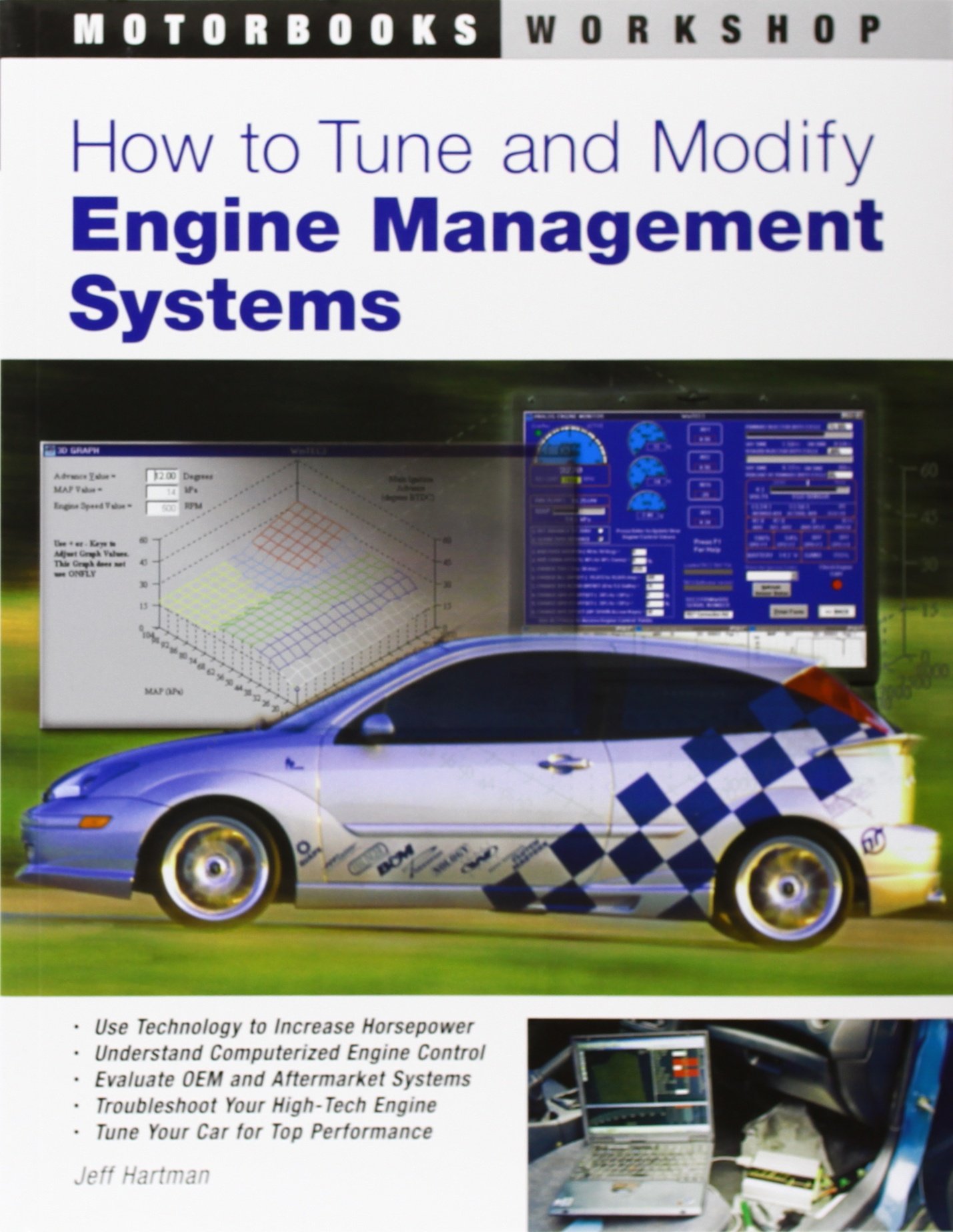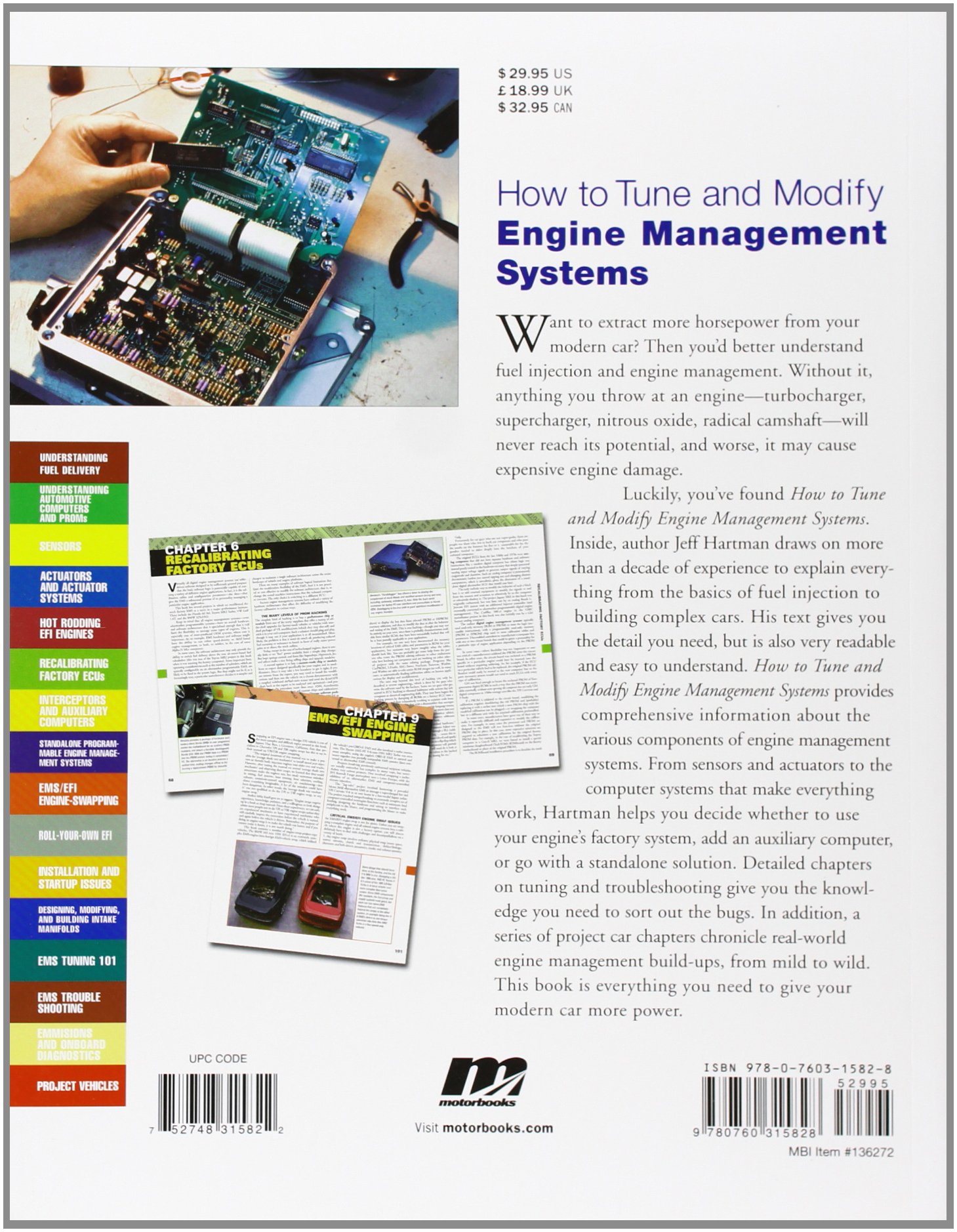


How to Tune and Modify Engine Management Systems (Motorbooks Workshop)
R**S
a must for begginers doing tunes
nice book. little dated say to AEM series one . not like todays AEM infinity management. but good EMS learning guide how to aproach tuning.
R**.
Excellent read for anyone interested in engine modification
I bought this to help me gain some insight about engine management and fueling taking on a turbo conversion project and it helped me to no end! I still use it to this day as a reference even to help formulate ideas for troubleshooting engines with running issues. It covers in-depth concepts and applications for engine management as well as giving some real life examples of putting it into practice. Whether you know a lot about engines or just want to gain an extra little bit of insight, this book is for you.
R**R
Holy Cow Why Didn't I Find This Book Sooner?
I have a few books from the "Motorbooks Workshop" series and I am happy with all of them - in fact I'm kicking around the idea of building a library of them for myself, as they are all instant reference books full of valuable information. I could waste a weekend away just thumbing through them.THIS BOOK is one of the best automotive "how-to" books I have ever read. Let me tell you why. I have been shying away from stand alone engine management in my search for power-adders on my cars. One of my cars is a mk2 Supra with a tired 5MGE engine and I've been wondering how long it will be before I have to do something about it. There aren't a lot of aftermarket companies out there who work with this engine. Do I rebuild the 5M with stock parts, new gaskets, and maybe a mild port and polish? This would save me the trouble of worrying about engine management, and it would be cheap(er). Or do I swap in the turbo 3.0 inline six 7MGTE from the later mk3? If I do this, I'll need to source a complete wiring harness, and what if the wires are cut, and then I can't figure out how to get it running? Or do I go crazy and swap a twin turbo 2JZGTE from a mk4? Same problem there. Or do I try something completely different and modify the 5M with independent throttle bodies, or build a grassroots centrifugal supercharger system for it? Or better yet, custom fab a subframe and shove an LS1 under the hood? I'm not worried about the fabrication, I'm worried about the wiring! Now it's not just a matter of finding a parts car with an intact wiring harness... I need to build an engine management system and that stuff is... well, scary. I don't know where to start, and I'm not ready to lay down the coin for some TEC III or Megasquirt Whatever thing if I don't know what I'm trying to buy. And the various forums I subscribe to can't offer me enough hands-on information to make an educated decision. I'm not going to pay $2000 for something just `cause everybody likes the cold air intakes made by the same company.Behold! From behind a curtain Jeff Hartman steps forward with this book. Chapter 1, starting on page 14 outlines the basics of my system in a clear and concise manner. Step 1: Get fuel to the engine compartment. Step 2: Build an intake manifold and throttle. Step 3: Figure out a way to meter fuel. Step 4: Turning the injectors on and off. Step 5: Telling the computer what's going on in the engine. Step 6: Startup. Step 7: Naming the system and making it smart. Step 8: How did we do? Step 9: Revisionist designs.Each step is explained in simple and effective detail. Yes, I had grasped these concepts conceptually before owning this book, but it is very nice to have them laid before me so neatly. There is good data in these first few pages. For instance, did you know that injectors should be designed around an 80% duty cycle? Also, most injectors cannot provide accurate flow below a threshold of 1.3 milliseconds open time. Jeff told me so. Perhaps this is in my copy of the Bosch Automotive Handbook, but Jeff's book has prettier pictures.Jeff also told me that an air/fuel mixture of 12.2 is optimum, which I had heard before. But Jeff told me *why*. Nobody has done that before. After explaining most of these basics, Chapter 2 is a breakdown of the functions of an ECU. Jeff doesn't just devote a sentence to the ECU, more than a page of tiny text is devoted to description of components of a simple ECU. He then explains the advantage of calibrated engine management over mechanical fuel injection - his goal is to teach you how to be able to drive your car on the track *and* the street, without the necessity of keeping the revs up and dreading every stoplight.Occasionally Hot Rod Magazine will have a column on "term of the month" or something like that. I like Hot Rod a lot. It's a good magazine that gets right down to the nuts and bolts of automotive enthusiasm. In these short technical columns, they will explain "volumetric efficiency" or some other complicated term. That stuff is all here, in much more detail. There are even *equations*. Who doesn't like equations?Chapter 3 is dedicated to sensors. Eleven dense pages of information on sensors. Jeff explains the function of every sensor in detail, including MAF, O2, crank position, throttle position, temperature sensors (for air, gas, and oil), torque and pressure sensors... you get it. Jeff isn't short-changing us. It's all here. I was flipping through Chapter 3 and stopped at a familiar picture. "Hey," I thought. "That looks just like my MAF for my Volkswagen VR6." Yep, it's a Bosch design, and Jeff knows all about it.Chapter 4: Actuator Systems. Jeff tells us all about the control of electronic fuel injectors - how they are built, equations for flow rates, and a huge chart of fuel injector specs from practically every Bosch, Nippon Denso, Lucas, or AC Delco injector on the market. Jeff doesn't care if you like American cars, German cars, Japanese cars, British cars, Italian cars, or whatever. He just likes cars. Me too. That's why I am in love with this book.With most of the fundamentals out of the way, Chapter 5 jumps right into "Hot Rodding EFI Engines." The first page has a picture of a supercharged LT1, and the second page of the chapter has a picture of a Porsche 968 turbo. Buy copies of Corky Bell's forced induction books in addition to Jeff's book, and you'll know all you need to know. In this chapter, he talks about the stuff we all like to talk about. Supercharging, turbocharging, nitrous, big lopy cams, different intake manifolds, exhaust, fuel delivery components, all that. He even devotes a little time to hot rodding Chevy's TPI and Ford's MPI.Chapter 6: Recalibrating Factory ECUs. This is the black magic I wanted to know about. Bam! Right away Jeff has a table of cars and available recalibration systems for those cars. It's not just the basic cars either. The list includes Honda, BMW, Buick, Ford, Chevy, VW, Nissan, Porsche, Toyota, Mazda, and Mitsubishi. Pick an engine, and Jeff knows about it. Audi 1.8T? Grand National turbo V6? Ford 5.0 or 4.6? It's in there. Then he shows how he removed a chip from a Mitsubishi 3000GT VR4 and learned to crack it. And look! A list of websites for hacking software. Jeff, you are the man. You have brightened my life.I am writing too much. And I'm only a quarter into the book. He tells us more about piggy back computers, stand alone systems (AEM, DTA, Autronic, APEXi, Accel - an incredibly comprehensive list of stand alone manufacturers and their kit specifications -prices too!!), swapping factory engine management systems, converting engines to EFI, common installation and startup problems, building intake manifolds (with equations!), EMS tuning on the dyno and troubleshooting (and the best tools to do it), and emissions and OBD systems.The last ~1/3 of the book is detailed descriptions of installations on a bunch of project cars (including a triple turbo Jaguar, a Lotus, a turbo Honda CRX, a twin-charged Toyota V6, a Golf 1.8T, and a '55 Chevy with a twin turbo small block). The project car sections are neat, but Jeff, I doubt that Golf 1.8T made 335 rear-wheel horsepower. But I'd believe you if you said "335 front-wheel horsepower." That's pretty much the only error I found.If you are into cars, and you are building a car of your own with a semi-exotic forced induction or naturally aspirated engine, get ahold of this book. It's the best I've seen.
S**R
Was gelernt
Habe das Buch erworben, weil ich ein tuningfähiges älteres japanisches Fahrzeug fahre.Kurz gesagt hat das Buch meine Erwartung erfüllt: Ich habe was über Motormanagement und insbesondere seine Entwicklung seit den 60er Jahren gelernt. Das ist insofern wichtig, dass man anhand dieser historischen Betrachtungen gut erkennen kann, wie einzelne Komponenten und Systeme zueinander und zu bestimmten Fahrzeugen passen.Zunächst gibt der autor eine kompetente Einweisung in die Grundlagen der elektronischen Motorsteuerung, der nötigen Sensorik und der Einflußmöglichkeiten.Dann folgen diverse Beispielprojekte, bei denen der Einsatz der Komponenten und ihre optimale Einstellung beschrieben wird. Allerdings wird hautpsächlich auf Turbomotoren eingegangen - was aber heutzutage wieder sehr interessant ist, denn das aktuelle Downsizing von Otto-Motoren (kleinerer Hubraum wird durch Aufladung kompensiert, dadurch bessere Verbracuhs- und Abgaswerte) wäre ohne elektronische Steuerung und Optimierung und Turb-Aufladung unmöglich.Mir hat das Buch einige Erkenntnisse und vor allem Systematik bei meinen Tuning-Überlegungen gebracht. Deshalb mein Urteil: Sehr empfehlenswert für Hobby-Tuner, aber auch für technisch interessierte Autofahrer.
J**Y
Highly Recommended for those getting into this!
For those looking for a user manual on how to tune a car... well this isnt it. But if you are looking for something that will give you the basis for understanding WHY you are doing certain things... THIS IS THE BOOK.Its largely based on explaining the history, progression, and improvements to engine management systems. Then breaks down in pretty good details what different factors or settings change in the engine, how to tune for them, and what the side effects could be.There is lots of theory, and lots of info here. For those just getting into the black art of engine management, or even just engine work in general, this book is a great base to build off of. With this book, and Max Boost from Corky Bell, you really should be on solid ground when diving into a forced induction setup, or dealing with Nitrous since theres lots of the book which talkes about Nitrous injection.One thing this book also does, is clearly caution a reader from just playing with engine management. It explains how touchy some of these settings are, and how easy it is to destroy an engine from mis management.
Trustpilot
1 day ago
2 weeks ago